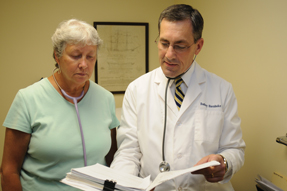Years after leaving practice, some doctors choose to return
Physicians sometimes take up the stethoscope again, years or even decades after having involved themselves in other personal or professional pursuits. Programs exist to draw these doctors back into clinical practice, where they are needed.
Rodney Hornbake, FACP, had been practicing for more than a decade when he left his rural North Carolina practice in the early 1990s, looking for new career opportunities and educational options for his children.
His quest led him to Rochester, N.Y., where he became chief of medicine in an organization with a multispecialty group practice, hospital and three nursing homes. When he later joined Aetna Professional Management Corporation, he stopped seeing patients altogether. He continued in administrative work and eventually helped launch a publicly traded company.

By the time the company sold a major division, his children were grown and he had a healthy nest egg. He once again felt the draw of clinical practice. “I had the luxury of being able to return to my first love,” he said.
Like Dr. Hornbake, a number of physicians leave their stethoscopes behind for an extended period to pursue careers in business, law, pharmaceuticals, insurance or other opportunities. Others need time away to raise families, care for a sick relative or recover from an illness.
Some choose to return once the illness has healed and the children have grown, or because they come to miss caring for patients. Moreover, a number of retired physicians have had to return after the economic downturn decimated their investment portfolios. According to a study of Arizona physicians, 604 of 13,215 physicians renewing their medical licenses between 2003 and 2006 were reentering practice, according to a report by the AMA Council on Medical Education. In the same report, North Carolina saw 94 physicians became active in the state after being inactive, whereas 47 returned to practice after retirement.
Regardless of the reasons they leave or their motivation to return, physicians will need to do more than hang out their shingle and roll up their sleeves. A number of challenges await them.
Navigating the landscape
Dr. Hornbake worked for a group practice for two years until he found the right permanent position, taking over the practice of a retiring physician in Essex, Conn. Fortunately, he had maintained medical licenses in a number of states and recertified in geriatrics. But he had to wait six months to attain credentials at a university hospital and get a Connecticut medical license. In the interim, he worked in a four-bed hospital at an Indian Health Service facility in North Dakota for a month, which helped him to assess his clinical skills and learn about newer pharmaceutical agents. “I was particularly confident at the end of that experience that I hadn't lost my clinical edge,” he said.
Although Dr. Hornbake had a smooth transition, experts agree that physicians can encounter a number of hurdles on their path to reentry, depending on the length of their absence, state board and credentialing requirements, and other factors. The American Academy of Pediatrics spearheaded and funded the Physician Reentry into the Workforce Project in 2006, addressing issues associated with physician reentry.
Physicians returning to clinical practice must above all demonstrate clinical competence as required by their respective boards, as well as having necessary credentials. “Probably one of the most important roadblocks that they have to get through, if they don't have an active license, is finding out what their state licensure board requires of them to do before the board will consider them for licensure or relicensure and to find the appropriate resources to meet those requirements, many of which require the physician to demonstrate current competence to practice,” said Elizabeth Grace, MD, medical director of CPEP, the Center for Personalized Education for Physicians in Denver.
Obtaining hospital privileges can be another major hurdle. Most hospitals have bylaws and regulations about the number of patients physicians need to have managed within a certain time frame, said Elizabeth Bower, FACP, MPH, assistant professor of medicine and assistant dean of continuing medical education at Oregon Health & Sciences University in Portland. “But if you've been out of practice, you haven't been able to do that,” she noted.
Furthermore, physicians with lapsed board certification should recertify and those with lifetime certification should strongly consider voluntarily enrolling in maintenance of certification, she added. This demonstrates their commitment to keeping their knowledge base up to date, which is helpful in the regulatory process and also provides educational value.
Filling in the gaps
Several programs throughout the country help guide physicians through this process. In fact, such programs may help physicians identify their needs and demonstrate their competence to state boards or credentialing boards, Dr. Grace said.
Physicians need to weigh the merits and requirements of each program. For example, costs vary, up to several thousand dollars a month or more. It's also important to factor in the need to temporarily relocate or cease working while retraining, which can take several months.
“We offer a course which is didactic, and it's focused on up-to-date, core issues in medicine. Then we offer a structured and yet individualized preceptorship,” said Nielufar Varjavand, MD, program director of the refresher course and a general faculty member in internal medicine at Drexel University College of Medicine in Philadelphia. The preceptorship includes assessments, daily rounds, clinics, conferences, computer exercises and a variety of other elements. To make it more convenient for participants, Dr. Varjavand said, Drexel just launched an online interactive reentry program.
Reentry programs can help physicians restore their confidence in their clinical skills and knowledge base. “There's a huge amount of new information in medicine and it's very difficult to assimilate,” Dr. Bower said. “And people who have been out of practice for awhile are fully aware of that.”
Dr. Grace agreed. “There are constantly new medications coming out, as well as new guidelines, and the standards of care seem to change so much more rapidly than they did 20 or even 10 years ago,” she said.
But such programs also can present unexpected role adjustments. “It's somewhat difficult for an experienced physician who was at the top of his or her game to leave and then come back and be a resident again,” said Leo A. Gordon, MD, coordinator of the physician reentry program at Cedars-Sinai Medical Center in Los Angeles.
Although reentry programs include assessments, the final decision on whether to allow a physician to return to clinical practice rests with credentials committees. “At the end of a reentry program, the best you can say is that the candidate actively participated in the reentry process and satisfactorily met the requirements for the reentry program,” Dr. Gordon said. “Credentials committees have the task of evaluating any reentry process and considering that process along with other qualifications.”
When returning independently, physicians need to identify gaps in their knowledge and find ways to fill them, Dr. Hornbake said. One way, he said, is to request to shadow clinicians in a group practice, asking questions and performing chart reviews. He also recommended having comprehensive reference materials such as a clinical information resource that can be accessed online via a computer or with a mobile device.
New beginnings
After the necessary requirements are fulfilled, physicians return to a variety of practice settings. “Our general impression is that there are no dominant trends,” Dr. Grace said. “We've had physicians who returned to the private practice setting, to the employed setting, to the government setting, like a Veterans Administration position. I would say a majority of people don't go into solo practice.”
Dr. Bower also has found that almost all of the graduates from her program have returned to primary care in a clinical setting where they are not solo practitioners. “Many of them have returned to underserved areas either in small towns here in Oregon or in working with underserved populations within cities,” she said.
The Maintenance of Practice Initiative of the Physician Reentry into the Workforce Project was designed to provide planning resources to physicians who plan to leave the workplace and reenter later. The initiative urges physicians who are contemplating leaving practice to plan ahead before doing so, said Dr. Bower, who was a delegate to the American Academy of Pediatrics/American Medical Association conferences on physician reentry in 2008 and 2010 and participated on the Credentialing, License, and Maintenance of Certification Working Group for the Physician Reentry into the Workforce Project. “Have a plan for how you're going to stay engaged and for what you're going to do.”
Dr. Hornbake agreed. “If you're leaving clinical practice for a clinically related job, for a management job, try to keep your hand in,” he said. “Try to see patients one day a week or a half day a week.” He also recommended recertification, participating in continuing medical education and attending meetings. “Try to stay current that way because you never know, you might go back into practice,” he said.
However, if physicians haven't been able to do that, they need to begin thinking about what their scope of practice will be so they can begin preparing, Dr. Bower said.
“You should definitely be enrolled in maintenance of certification in your specialty,” she said. “Look into your state's rules about reactivating your license. Volunteer work can be very helpful. If physicians are thinking about coming into practice and they can start off by doing volunteer work in a free clinic or an underserved area, that's often a very good way to get started.”





